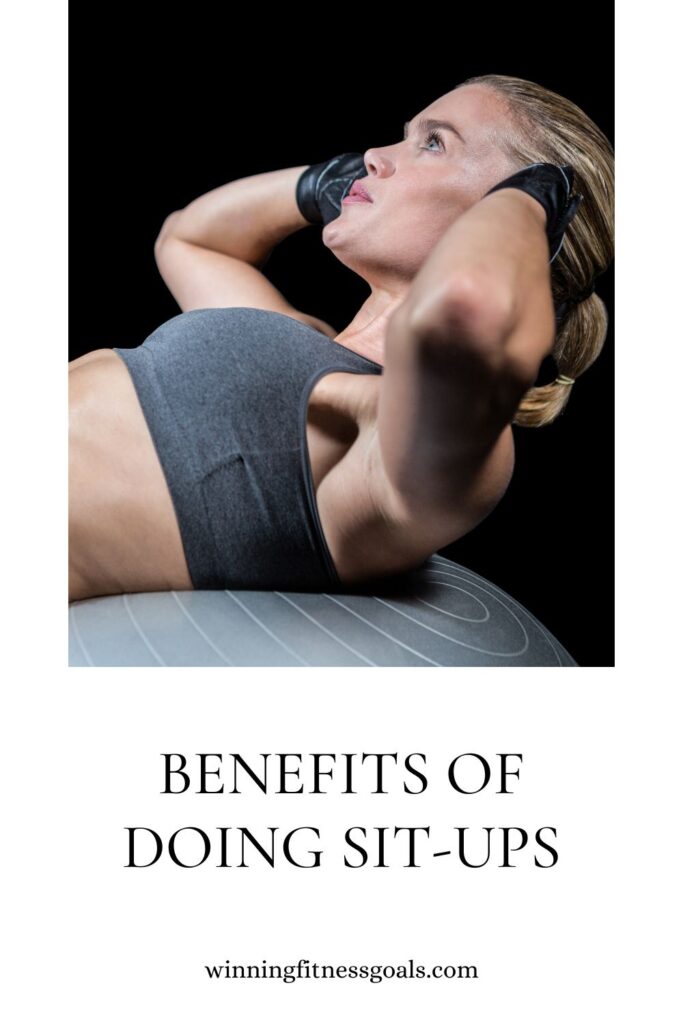Sit-ups are a popular exercise that primarily targets the muscles in the abdominal area. While they have been a staple exercise for strengthening the core for many years, it’s worth noting that sit-ups alone may not be the most effective exercise for achieving overall fitness or developing a six-pack. Nonetheless, what are the benefits of doing sit-ups:

Core Strength
Sit-ups engage multiple muscles in the core, including the rectus abdominis (the “six-pack” muscles), transverse abdominis, obliques, and hip flexors. Strengthening these muscles can improve your overall core stability and support your spine, leading to better posture and reduced risk of lower back pain.
Abdominal Muscle Definition
Doing sit-ups can contribute to toning and defining your abdominal muscles. By engaging and challenging your core, sit-ups can help develop the appearance of a more sculpted midsection.
Functional Fitness
A strong core is essential for everyday activities and sports performance. Sit-ups can improve your ability to perform tasks that involve bending, twisting, lifting, and maintaining stability, thereby enhancing your overall functional fitness.
Improved Posture
Weak core muscles can contribute to poor posture, leading to back pain and other issues. By strengthening your core, sit-ups can help you maintain better posture, reducing the risk of back problems and enhancing spinal alignment.
Injury Prevention
Again, weak abdominal muscles can contribute to poor posture and increase the risk of lower back pain and injuries. By strengthening your core through sit-ups, you may help stabilize your spine, improve posture, and reduce the likelihood of certain injuries.
Improved Flexibility
Performing sit-ups regularly can help improve flexibility in your hip flexors and lower back. This increased flexibility can enhance your range of motion in daily activities and other exercises.

Convenience
The best thing about sit-ups, they are a simple and convenient exercise that can be done almost anywhere, requiring minimal equipment. You can perform sit-ups at home, in the gym, or even in a hotel room when traveling.
Cost-Effective
Doing sit-ups does not require any specialized equipment, making them a cost-effective exercise option. You don’t need to purchase expensive machines or join a gym to incorporate sit-ups into your fitness routine.
Versatility
While the primary focus of sit-ups is on the abdominal muscles, they also engage other muscle groups, such as the hip flexors and chest muscles, to a lesser extent. This versatility allows for a more comprehensive workout for multiple muscle groups.
Variations and Progression
The best part is, sit-ups offer various variations and progressions, allowing you to target different areas of the abdominals or increase the difficulty as your strength improves. Examples include decline sit-ups, weighted sit-ups, or incorporating twists to engage the obliques.
Enhanced Athletic Performance
A strong core is vital for various sports and physical activities. By incorporating sit-ups into your exercise routine, you can improve your core strength, stability, and rotational power, which can translate to better performance in activities like running, swimming, or playing sports.
Metabolic Boost
Like other forms of exercise, sit-ups can contribute to an increased metabolic rate, helping you burn calories and potentially aiding in weight management or weight loss goals.
Mental Health Benefits
Just like any exercise, sit-ups can contribute to your overall mental well-being. Regular physical activity, including sit-ups, promotes the release of endorphins, which are known as “feel-good” hormones. These endorphins can improve mood, reduce stress, and enhance cognitive function.
Remember, it’s essential to perform sit-ups with proper form to avoid strain or injury. If you have any underlying health conditions or concerns, it’s advisable to consult with a healthcare professional or a certified fitness trainer before starting a new exercise regimen.

